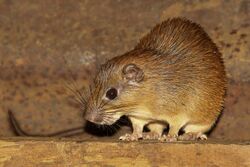Biology:Echimyini
| Echimyini | |
|---|---|

| |
| Mesomys hispidus | |
| Scientific classification | |
| Domain: | Eukaryota |
| Kingdom: | Animalia |
| Phylum: | Chordata |
| Class: | Mammalia |
| Order: | Rodentia |
| Superfamily: | Octodontoidea |
| Family: | Echimyidae |
| Subfamily: | Echimyinae |
| Tribe: | Echimyini Fabre et al. 2016 [1] |
| Genera | |
|
Dactylomys | |
Echimyini is a tribe of echimyid rodents, proposed in 2016, and containing 13 extant genera: all of the tree rats Echimys, Phyllomys, Makalata, Pattonomys, Toromys, Diplomys, Santamartamys, and Isothrix, the long recognized dactylomines Dactylomys, Olallamys, and Kannabateomys, and the enigmatic and previously classified as eumysopines Lonchothrix and Mesomys.[1][2] All these spiny rats genera are arboreal. Worth of note, the arboreal genus Callistomys – the painted-tree rat – does not belong to the tribe Echimyini. Because it is phylogenetically closer to Myocastor, Hoplomys, Proechimys, and Thrichomys than to the above-mentioned Echimyini genera, it is classified in the tribe Myocastorini.[3][2]
Phylogeny
Five assemblages can be distinguished in the genus-level cladogram of Echimyini:
- Echimys is closely related to Phyllomys, Makalata, Pattonomys and Toromys. This clade is in accordance with the fact that Phyllomys was classified within Echimys,[4] and that Pattonomys and Toromys were placed in Makalata.[5]
- Dactylomys, Olallamys, and Kannabateomys share unique features, and these South American bamboo rats are grouped under the informal clade name of "Dactylomyines".[1]
- Diplomys and Santamartamys are sister group, reflecting the fact that the latter genus has been split from the former.[6]
- Lonchothrix and Mesomys are sister group, and have often been classified within "Eumysopines", a subfamily otherwise shown to be polyphyletic.[1]
- Isothrix occupies an isolated, deep-branching position.
| Genus-level cladogram of the Echimyini. |
References
- ↑ 1.0 1.1 1.2 1.3 Fabre, Pierre-Henri; Patton, James L.; Leite, Yuri L. R. (2016). "Family Echimyidae (hutias, South American spiny-rats and coypu)". Handbook of the Mammals of the World. Vol 6. Lagomorphs and Rodents I. Barcelona: Lynx Edicions. pp. 552–641. ISBN 978-84-941892-3-4.
- ↑ 2.0 2.1 Fabre, Pierre-Henri; Upham, Nathan S.; Emmons, Louise H.; Justy, Fabienne; Leite, Yuri L. R.; Loss, Ana Carolina; Orlando, Ludovic; Tilak, Marie-Ka et al. (2017-03-01). "Mitogenomic Phylogeny, Diversification, and Biogeography of South American Spiny Rats". Molecular Biology and Evolution 34 (3): 613–633. doi:10.1093/molbev/msw261. ISSN 0737-4038. PMID 28025278.
- ↑ Loss, Ana; Moura, Raquel T.; Leite, Yuri L. R. (2014). "Unexpected phylogenetic relationships of the painted tree rat Callistomys pictus (Rodentia: Echimyidae)". Natureza on Line 12: 132–136. http://www.naturezaonline.com.br/natureza/conteudo/pdf/05_LossACetal_132-136.pdf.
- ↑ Eisenberg, J. F.; Redford, K. H. (May 15, 2000). Mammals of the Neotropics, Volume 3: The Central Neotropics: Ecuador, Peru, Bolivia, Brazil. University of Chicago Press. pp. 487–488. ISBN 978-0-226-19542-1. OCLC 493329394. https://books.google.com/books?id=p2MDAzCeQQoC&pg=PA487.
- ↑ Woods, C.A.; Kilpatrick, C.W. (2005). "Infraorder Hystricognathi". in Wilson, D.E.; Reeder, D.M. Mammal Species of the World: A Taxonomic and Geographic Reference (3rd ed.). Johns Hopkins University Press. pp. 1538–1600. ISBN 978-0-8018-8221-0. OCLC 62265494. http://www.departments.bucknell.edu/biology/resources/msw3/browse.asp?id=13400440.
- ↑ Emmons, Louise Hickock (2005). Mammalian Diversification: From Chromosomes to phylogeography (A Celebration of the Career of James L. Patton). 133. University of California Press. pp. 247–310. ISBN 9780520098534.
Wikidata ☰ Q48839418 entry
 |

